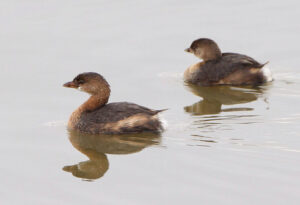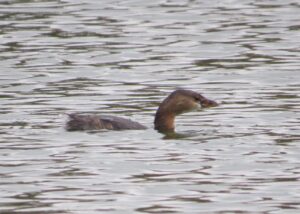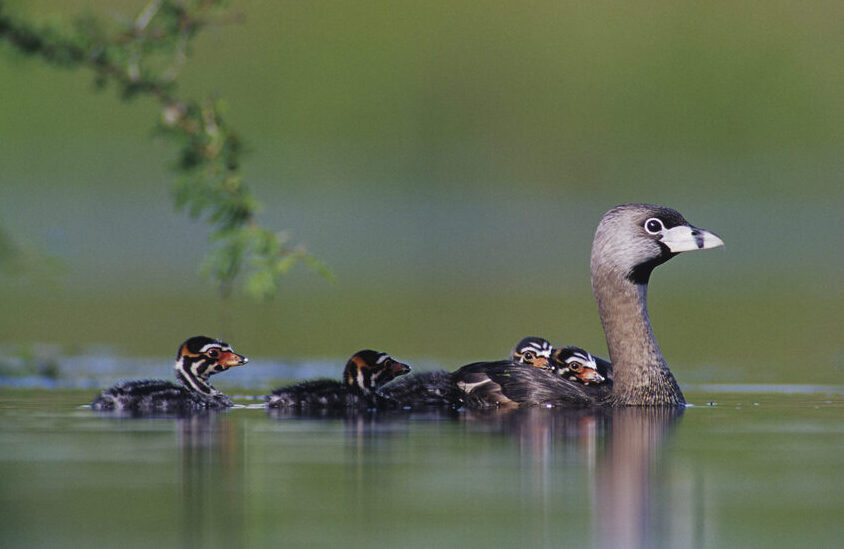Pied-billed Grebe, Podilymbus podiceps
Bill Rowe
Within any given class of living things, the first big subdivisions are the orders. Thus, among the class Aves, birds that belong to different orders are widely separated in evolutionary terms, i.e., not closely related to each other. This means that ducks are widely separated from other swimming birds that belong to various other, different orders, like loons, coots, cormorants—and grebes, perhaps the most unfamiliar of these groups to anyone who hasn’t yet studied birds. A typical first reaction, upon seeing one’s first Pied-billed Grebe swimming on a lake, is apt to be “What kind of duck is that?” and then, upon hearing the identification, “What’s a grebe?” So let’s consider what makes grebes different. Among other things, instead of webbed feet, they have flat lobes around each toe that help them swim; but their feet are set far back on their body, and they can’t really walk on land at all. The structure of their body feathers allows them to change their buoyancy, so that they can swim with their whole body above the waterline or progressively less of it, down to just their head above water. Most of them, including the other six North American species, have bills that are thin and sharp-pointed, like a spike or a knife blade, while the common and widespread Pied-billed Grebe has a thick bill, curved above and below, shaped like that of a tanager or perhaps a chicken. Pied-bills nest in marshes, on a mat of plant material that may be anchored to vegetation growing around it (like reeds) or just floating freely in the water. One way to discover them in the marsh is to listen for their song—a loud, long series of throaty whoops and clucks, sort of a “jungle soundtrack”; be sure to listen to it in the link below. Outside the nesting season, they leave the marshes and can be seen on any quiet body of water, and when migrating they may gather into flocks, usually fairly small but sometimes up to hundreds.
IDENTIFICATION: No other swimming bird is like a Pied-billed Grebe: it’s small, not quite as big as a teal; it is mainly dark brown; it has a thick neck and head, with a snaky, curved profile; and it has a thick bill that is whitish with a black band around the middle (breeding season) or just all darkish (fall and winter). With any kind of decent look, it is clearly not a duck, and it doesn’t resemble other grebes either. Juvenile Pied-billed Grebes have a multicolored striped pattern on the head and neck (see top photo).
ST. LOUIS STATUS: Uncommon as a summer breeding bird, but generally present wherever there are good marshes to nest in. On migration, common and expectable on any body of water from ponds to large lakes and bays, with a fall peak in October. In winter, uncommon to rare, depending on the presence of open water.
Learn more and listen to the songs and calls of Pied-billed Grebes here.


Nonbreeding plumage
and typical posture
Photo Credit: Al Smith
Nonbreeding, partly submerged
Photo Credit: Bill Rowe




